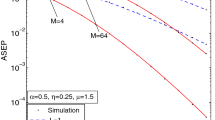Abstract
A novel pilot-symbol-aided (PSA) fading estimation technique that combines the estimates from a conventional PSA technique and a bandwidth-efficient PSA technique to achieve better performances is proposed for digital signals in multipath fading channels. The conventional technique has better performances at low signal-to-noise ratios (SNRs), while the bandwidth-efficient technique is superior at high SNRs. Monte Carlo computer simulation has been used to assess the effects of the proposed combining technique on the bit-error-rate (BER) performances of 16-ary quadrature-amplitude-modulation (16QAM), with and without two-branch diversity reception, in a flat Rayleigh fading channel. Results have shown that the combining technique has the advantages of both of the conventional technique and the bandwidth-efficient technique and is more preferred for use with diversity reception.
Similar content being viewed by others
References
J.K. Cavers, An analysis of pilot symbol assisted modulation for Rayleigh fading channels, IEEE Trans. Veh. Technol. 40(4) (1991) 686–693.
G.T. Irvine and P.J. McLane, Symbol-aided plus decision-directed reception for PSK/TCM modulation on shadowed mobile satellite fading channels, IEEE J. Select. Areas Commun. 10(8) (1992) 1289–1299.
H.K. Lau and S.W. Cheung, A pilot symbol-aided technique used for digital signal in multipath environments, in: Proc. IEEE Int'l Conf. Commun. New Orleans, USA, (May 1994), pp. 1126–1130.
Y. Liu and S.D. Blostein, Identification of frequency non-selective fading channels using decision feedback and adaptive linear prediction, IEEE Trans. Commun 43(2–4) (1995) 1484–1492.
C.L. Liu and K. Feher, Pilot-symbol aided coherent M-ary PSK in frequency-selective fast Rayleigh fading channels, IEEE Trans. Commun. 42(1) (1994) 54–62.
C. Loo and N. Secord, Computer models for fading channels with applications to digital transmission, IEEE Trans. Veh. Technol. 40 (1991) 700–707.
J. Lu, T.T. Tjhung and C.C. Chai, Error probability performance of L-branch diversity reception of MQAM in Rayleigh fading, IEEE Trans. Commun. 46(2) (1998) 179–181.
M.L. Moher and J.H. Lodge, TCMP-A modulation and coding strategy for Rician fading channels, IEEE J. Select. Areas Commun. 7(9) (1989) 1347–1355.
M.H. Ng and S.W. Cheung, Bandwidth-efficient pilot symbol aided technique, Electronics Letters 34(16) (1998) 1548–1550.
H.V. Poor and G.W. Wornell (eds.), Wireless Communications: Signal Processing Perspectives New Jersey: Prentice Hall, (1998).
S. Sampei and T. Sunaga, Rayleigh fading compensation for QAM in land mobile radio communications, IEEE Trans. Veh. Technol. 42(2) (1993) 137–147.
M. Sawahashi and F. Adachi, Multicarrier 16QAM transmission with diversity reception, Electronics Letters 32(6) (1996) 522–523.
P. Schramm and R.R. Muller, Pilot symbol assisted BPSK on Rayleigh fading channels with diversity: performance analysis and parameter optimization, IEEE Trans. Commun. 46(12) (1998) 1560–1563.
T. Sunaga and S. Sampei, Performance of multi-level QAM with post-detection maximal ratio combining space diversity for digital land-mobile radio communications, IEEE Trans. Veh. Technol. 42(3) (1993) 294–301.
Z. Zvonar, P. Jung and K. Kammerlander (eds.), GSM: Evolution Towards 3rd Generation Systems Boston: Kluwer, (1999).
Author information
Authors and Affiliations
Corresponding author
Additional information
Man-Hung Ng received a BSc degree in Computer Studies from City University of Hong Kong in 1991. He worked as a computer programmer in Hong Kong from 1991 to 1995. In 1996, he obtained a MSc degree in Communication and Radio Engineering from King's College London. He joined the University of Hong Kong as a research assistant in 1997, and completed a PhD degree in mobile communications in 2001. He joined Lucent Technologies N.S. UK in 2001 and is now a principal standards engineer.
Sing-Wai Cheung received the BSc degree in Electrical and Electronic Engineering from Middlesex University, U.K. in 1982 and the PhD degree from Loughborough University of Technology, U.K. in 1986. From 1986–1988, he was a post-doctorate research assistant in the Communications Research Group of King's College, London University. During 1988–1990, he was with the Radio and Satellite Communications Division in British Telecom Research Laboratories (now British Telecom Laboratories). He joined the Department of Electrical and Electronic Engineering at the University of Hong Kong in 1990 and is now an Associate Professor. He contributes regularly courses on mobile and satellite communications systems. His current research interests include modulation, coding, fading compensation and diversity and MIMO for mobile and satellite communications systems.
Rights and permissions
About this article
Cite this article
Ng, M.H., Cheung, S.W. Combining Pilot-Symbol-Aided Techniques for Fading Estimation and Diversity Reception in Multipath Fading Channels. Wireless Netw 12, 233–240 (2006). https://doi.org/10.1007/s11276-005-5271-1
Published:
Issue Date:
DOI: https://doi.org/10.1007/s11276-005-5271-1




